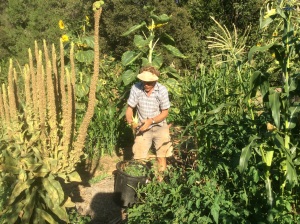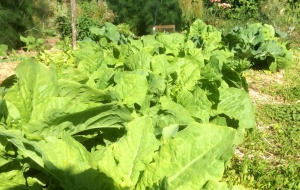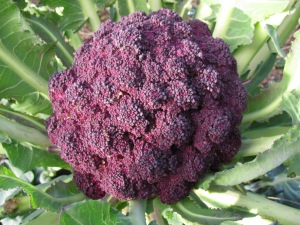Nevada County residential treated water customers are being required by the state to reduce their water usage by a whopping 36% starting in June. That’s a figure that brings up images not just of brown lawns but of withering landscapes and shriveled vegetable gardens.
This was the vision in my head fifteen years ago when my husband and I drilled our first well. The well drilller had gone as deep as we could afford, and I still remember the sense of loss and frustration I felt as he told me we had a gallon and a half per minute. For a gardener-farmer with big dreams that was a devestatingly small amount. Yet that moment marked the beginning of my personal journey in understanding water.

This young mulberry tree thrives and bears fruit with almost no supplemental water, even though the pond behind it has dried up early for 3 years now.
As a certified permaculture designer with 25 years of ecological landscaping experience, I know that it is possible to make big cuts in our water usage while growing food and maintaining healthy landscapes. In fact, many drought-proofing strategies also act to improve soil quality, recharge groundwater, recycle nutrients, and enhance the health of the entire watershed.
But what strategies are right for your situation? Should you mulch or does that create too much fire danger? Do you need a new irrigation system or would investing in a greywater system serve you better, or are both essential? Are swales appropriate for your land or should you try hugelkultur? Are there other options to consider?
These are long-term decisions and investments. When made wisely, from a holistic perspective, they can increase your personal resilience and this community’s resilience not only to drought but to a changing climate as well.
This is why I have created a 2-day workshop designed to offer a comprehensive experience that will save you time and money by ensuring that you have the information you need to make the best choices for your property and for your future. In this workshop you will learn:
- The 4 top techniques to make your property resilient to drought.
- Tools for safely and efficiently recycling water from your home to your landscape.
- How to grow an abundant vegetable garden with limited water.
- Watering techniques that save water and your landscape.
- What food and insectary plants are truly drought resistant.
- How your daily food choices impact our water supply, and how you can improve your health while caring for water, restoring ecosystems, and increasing sustainability.
We will discuss the role of living organisms in the water cycle and what you can do to enhance the full cycle. We will also touch on the amazing nature of water and its role in creating and maintaining life.
You will come away from this workshop not only with practical knowledge and skills, but also feeling empowered, optimistic, and inspired to live sustainably with water.
Saturday and Sunday, June 27 & 28 from 10 am to 5:30 pm
Bluebird Farm, 11153 Cement Hill Road, Nevada City, CA 95959 Contact: renee.bluebirdfarm@gmail.com Price: $180 per person early bird registration before June 22. ($210 per person at the door.) $150 per person when you register with a friend before June 22.
To register, please use the contact form on this website or the email listed above. I will send you information on how to complete the process.
This workshop is taught by Renee Wade, with guest teachers Matt Berry and Tom Wade.  Renee Wade is a Certified Permaculture Designer with 15 years experience living with low-flow (and sometimes no-flow!) wells. She understands intimately the tools, techniques, and possibilities of water conservation. She is dedicated to helping people live beautifully and abundantly through understanding and working with the natural world.
Renee Wade is a Certified Permaculture Designer with 15 years experience living with low-flow (and sometimes no-flow!) wells. She understands intimately the tools, techniques, and possibilities of water conservation. She is dedicated to helping people live beautifully and abundantly through understanding and working with the natural world.  Matt Berry is a Certified Professional Greywater Designer & Installer with a background in Ecology. Learn more at http://www.SierraLivingSkills.com
Matt Berry is a Certified Professional Greywater Designer & Installer with a background in Ecology. Learn more at http://www.SierraLivingSkills.com  Tom Wade is a Certified Permaculture Designer, professional organic landscaper, and grazier. He is passionate about restoring the fertility and hydration of western lands through the intelligent use of ruminant animals. He is also a professional storyteller known for his ability to captivate any audience.
Tom Wade is a Certified Permaculture Designer, professional organic landscaper, and grazier. He is passionate about restoring the fertility and hydration of western lands through the intelligent use of ruminant animals. He is also a professional storyteller known for his ability to captivate any audience.







 “THERE are no isolated islands in an electric universe, from the smallest particle to the largest galactic formation.
“THERE are no isolated islands in an electric universe, from the smallest particle to the largest galactic formation.









